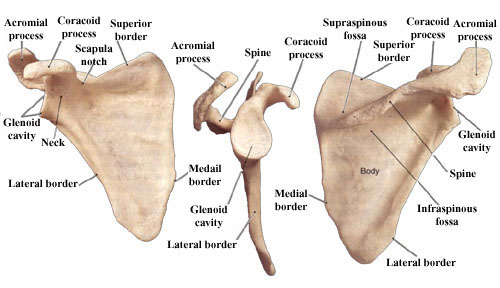 It has been a very technical, anatomy driven week of blogging. Hopefully I will bring it all together next week discussing the concept of shoulders on the back and how all of the muscles of the shoulder girdle work to bring balance to the upper body.
It has been a very technical, anatomy driven week of blogging. Hopefully I will bring it all together next week discussing the concept of shoulders on the back and how all of the muscles of the shoulder girdle work to bring balance to the upper body.
The shoulder blade, or scapula, is one of the two bones that make up the shoulder girdle. As mentioned before the shoulder girdle is designed to hang from the head without touching the rib cage.
The Scapula is meant to be held in place by an assortment of muscles. The upper trapezius connects to the occipital bone and the acromion process of the shoulder blade. The rhomboids major and minor (the subject of the next post) along with levator scapula, form broad attachments from the inner edge of the shoulder blade to the spine. The teres major and minor connect the scapula to the upper arm bone (humerus). The serratus anterior connects the lower ribs to the underside of the scapula adjacent to the attachment of the rhomboids.
The elasticity of each of these muscles allow for the scapula to float on the top of the rib cage. Tightness in any of them will create tightness in the others and will fix the shoulder blade which can reduce the flexibility of head, upper back, and arms. Hopefully everything I write reinforces the need for balance between opposing muscle groups. Dysfunction in any muscle is sure to influence all the muscles around it.
When the arm is raised the scapula follows it towards the outside of the body. If all goes well the movement of the scapula is limited by balance between rhomboids, serratus anterior and teres major. If this is in fact what happens, the scapula retains its vertical pattern and the arm moves by proper adjustments of other important muscles. What is known as a winged scapula indicates weak rhomboids that fail to get involved in the aforementioned dance of the shoulder blade muscles.
When the shoulder girdle is in its optimal position the medial margin (inner edge) of the shoulder blade should be parallel to the spine. When the arm is hanging it swings from the shoulder blade but when we reach up the shoulder blade hangs from the arm.
To repeat an important note from the previous post, because the shoulder girdle is less stable than the pelvis and higher up off the ground it is much more vulnerable to injury and dysfunction. Good posture and proper placement of the pelvis is essential to having a well aligned and correctly functioning shoulder girdle.
***
